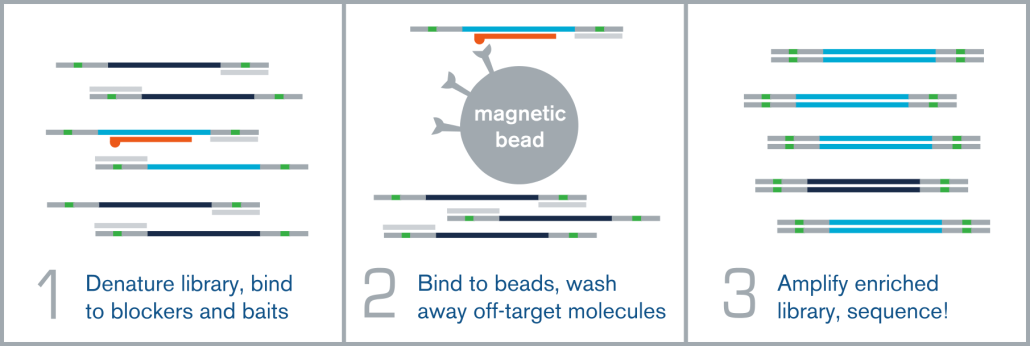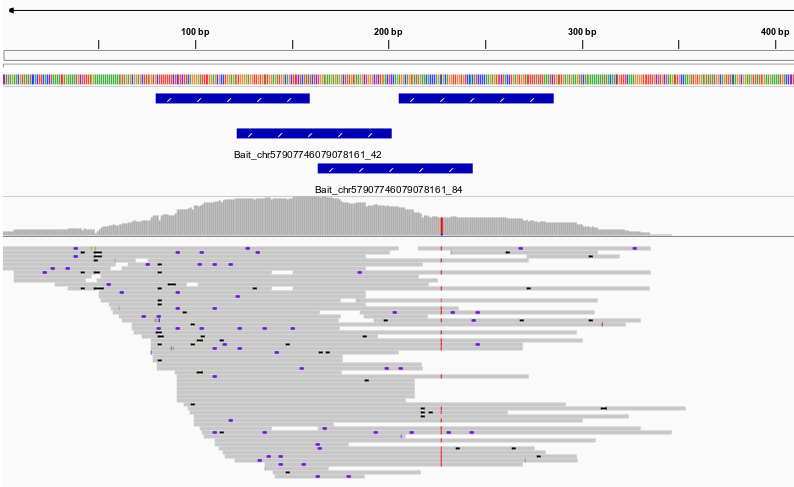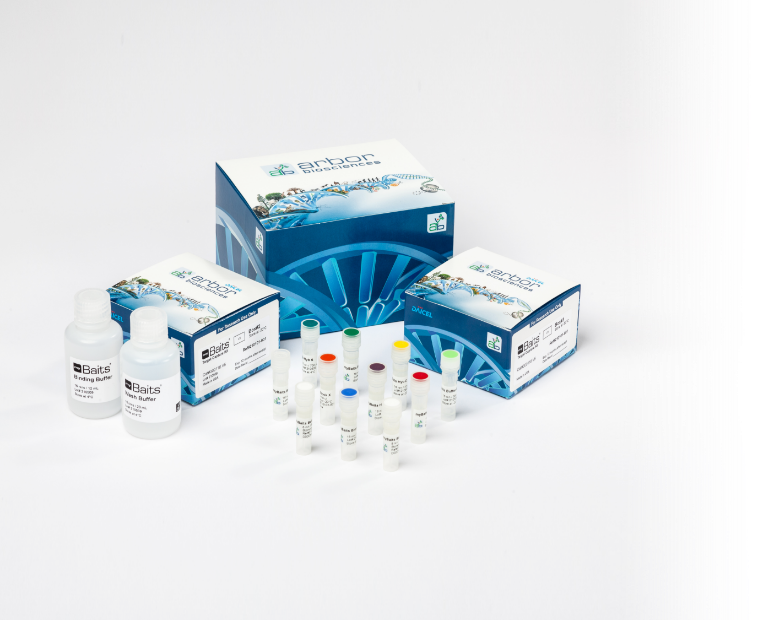Overview
myBaits® Custom Hybridization Capture Kits for targeted DNA sequencing have been used successfully in research projects from hundreds of genome types including animals, plants, and microbes and from fresh, degraded, and environmental DNA sources.
In-solution probes enable specific, yet flexible, hybridization to complementary target molecules, providing the ability to recover variable regions from taxonomically divergent species and strains. myBaits capture probes can be successfully employed even on non-model organisms which lack a sequenced genome or transcriptome.
myBaits kits can be easily integrated into your own research workflows—or paired with our customizable Sequencing or Bioinformatics services for a seamless NGS solution.
Affordable and scalable—Our proprietary oligo synthesis platform allows flexible production of high-quality baitsets at extremely competitive pricing for any project size.
Flexible design—Design your probes from any nucleic acid source: genomes, transcripts, SNPs, and more.
Broad range of panel sizes—Kits can accommodate any size target from a single locus to tens of thousands of loci, as well as an assortment of kit reaction sizes to accommodate any number of samples.
Access to expertise—Our team of expert scientists can provide complimentary bait and project design assistance.
Easy to use—Easy to follow protocol delivers consistently reproducible results, making myBaits kits ideal for new or expert users.
Convenient kits—Each myBaits kit includes probes and hybridization/washing reagents.
myBaits kits are for research use only and are not validated for diagnostic or therapeutic purposes.
Performance
myBaits Custom kits frequently achieve high on-target read percentages and/or high unique read complexity for most applications, creating significant savings compared to “shotgun” sequencing approaches. Our scientists are continually innovating novel improvements to the speed, ease of use, and performance of our myBaits kits across a variety of applications. We are always available to provide experimental design advice to maximize your targeted NGS success.
Figure 1. Typical example visualizing NGS reads from enriched human gDNA library. Single-end NGS reads are shown aligned to the hg38 genomic reference sequence. Positions of the four 80nt myBaits probes in this region are indicated by blue bars. Unique read coverage is highest across the baited region and tapers off upstream and downstream of the baited region. If sequencing further into the known or unknown flanking regions is desired, simply increase the length of your NGS library molecules (compatible with any myBaits kit).
myBaits kits are for research use only and are not validated for diagnostic or therapeutic purposes.
Research Applications
myBaits Custom DNA-Seq kits are ideal for enriching NGS libraries built from extracted DNA for:
- Gene or exon resequencing
- Novel variant discovery
- Phylogenetics
- Transgene detection
- And more
The kits perform well with a wide variety of sample types, including:
- Genomic DNA
- Metagenomic DNA
- Environmental DNA
- Ancient DNA
- Museum DNA
- FFPE samples
- cfDNA
- ctDNA
- Plant, animal, virus, bacteria, human
myBaits kits are for research use only and are not validated for diagnostic or therapeutic purposes.
Resources
Product Literature
Poster
A universal targeted sequencing system for any high-throughput sequencing platform
Application Note
Application Note
Publication Note
Targeting the “Resistome”: Sequencing Antimicrobial Resistance Genes with myBaits DNA-Seq Capture
myBaits kits are for research use only and are not validated for diagnostic or therapeutic purposes.
FAQs
No. myBaits hybridization capture kits have always been-- and will continue to be-- compatible with any user-provided upstream NGS library preparation system that is appropriate for a given project. This ensures flexibility in your targeted next-generation sequencing workflow.
However, for your convenience, we are now offering our own powerful kit for preparing NGS libraries from most types of DNA samples, which is relevant for many myBaits hybridization capture projects. This new product (Library Preparation Kit for myBaits) is intended to be used for the preparation of NGS libraries from dsDNA samples prior to hybridization capture with myBaits.
In addition to the upstream library preparation steps, the Library Prep Kit for myBaits includes the reagents necessary for performing the post-capture amplification step of the myBaits protocol.
myBaits hybridization capture kits include:
- Biotinylated RNA probes, with sequences corresponding to your custom design or a predesigned catalog option
- Hybridization and wash reagents
- For myBaits Custom kits, optional custom probe design informatics service (= expert bioinformaticians design and filter bait sequences and provide summary report and recommendations)
You will receive enough probes and reagents for performing the stated number of individual capture reactions of your kit size (e.g., 16 reactions) according to our current protocol. Please note that there are some additional reagents and equipment you will need to supply in order to perform a myBaits capture. Please review the list of required materials in the applicable myBaits manual to make sure you have everything you need before starting your experiments.
We also offer reagents for preparing libraries from DNA samples in advance of performing the myBaits hybridization capture step. Please visit Library Prep Kit for myBaits for more information.
If you are looking to outsource your project to a full-service laboratory and bioinformatics services group, please visit our myReads NGS laboratory and bioinformatics services page for more information about our comprehensive targeted sequencing service options (library preparation, target capture, next-generation sequencing, and optional analysis).
In the context of hybridization capture for targeted next generation sequencing, we use the terms interchangeably. Some fields prefer one term over the other, so we use both terms.
Turnaround time for myBaits targeted next generation sequencing kits varies based on design.
For new myBaits Custom baitset designs, the estimated manufacturing lead time is ~3-4 weeks minimum, starting from when your order is received and you have approved the final design. In addition, please consider that if you utilize our included bait design services, we will typically be in correspondence for an additional upfront period (up to several weeks) regarding a design before manufacturing can begin. Please also remember to accommodate any additional time for your collaborators to approve the final design, if applicable.
For myBaits Expert (catalog) kits or reorders of myBaits Custom kits with designs previously manufactured by Daicel Arbor Biosciences, the estimated manufacturing lead time is up to ~1-2 weeks from the time an order is received.
All myBaits kits include a specific protocol for their use as well as almost all of the reagents required to deploy them. In the manual, you will find the complete list of required supplies (reagents and equipment) that you will need in order to perform the captures.
Please see the applicable myBaits manual for detailed protocol instructions for enriching from Standard, High-Sensitivity, Long-Insert, or other specialty target/sample types.

Hybridization capture is integrated into the overall next generation sequencing workflow immediately before sequencing on an NGS platform, such as Illumina. A fully sequenceable, barcoded/indexed NGS library (or pool of multiple libraries) is denatured, and allowed to anneal to complementary target-specific biotinylated probes/baits. These bait:library complexes are then bound to streptavidin-coated magnetic beads via the biotin on the probes, which are washed to remove non-specifically bound molecules. The remaining “enriched” library molecules are then released from the baits and amplified before sequencing.
Note! You may know the “hybridization capture” technique by another name, such as:
- Target enrichment
- Target capture
- Probe capture
- Exon capture
- Capture sequencing / sequence capture
- Hybridization sequencing / hyb-seq
- Hybridization capture / hyb-cap
Specific recommendations for per-library input mass for different enrichment project types can be found in the applicable myBaits manual.
Target capture necessarily requires subjecting your libraries to a bottleneck, wherein target molecules are captured and therefore enriched, and non-target molecules are therefore removed. To have sufficient unique molecules for good sequencing coverage of your targets, successful captures DEPEND on the input of sufficiently complex libraries.
For best results, it is recommended that only amplified (non-PCR-free) NGS libraries are used for target capture. This provides multiple copies of each starting template molecule, increasing the chance of each individual molecule getting enriched. However if you need more starting material to reach the recommended amount, it is generally preferable to generate more library from fresh genomic DNA or a new batch of indexed library, rather than through extra amplification. This is because while some amplification is good, over-amplification risks reducing the observable complexity of your libraries through the uneven action of PCR bias, as some molecules will become relatively more abundant while others become rare. This is also true for manipulating your libraries after capture: amplify your post-capture libraries the minimum number of cycles necessary to reach the molarity required by your sequencing facility.
The applicable myBaits manual covers some common technical questions and troubleshooting topics at the end of each protocol. Please read through the relevant section first as it may answer your question. If you still have an issue, please contact us via email at techsupport_at_arbor.daicel.com or reach out to your most recent contact person for assistance.
When ordering your myBaits kit, please indicate the sequencing library configuration you intend to enrich. The standard adapter blocking reagent provided with the kit (Block X) is compatible with Illumina® TruSeq®-style or Nextera®-style libraries with single 6-12 bp or dual 6-12 bp indexing. These options cover the vast majority of currently available commercial library preparation systems intended for sequencing on any Illumina platform.
For different adapter configurations than those described above, we recommend ordering Custom IDT® xGen® Blocking Oligos. At a concentration of 1 μg/μL, custom adapter-blocking oligos can be used in lieu of myBaits Block X.
If you are not certain, or later decide to change your library prep kit, please contact us so we can instruct you on how to obtain the correct blocking oligos.
Yes! Our expert myReads team provides a range of in-house NGS services, including library preparation, target capture with myBaits, high-throughput sequencing, and optional bioinformatics analysis. Visit the Sequencing Services page to learn more about our comprehensive laboratory and sequencing service options!
Yes! As long as we receive written permission from the original designer(s) (if it is not your kit and the bait sequences are not publicly available), you can re-order any past design that has been manufactured by Daicel Arbor Biosciences. We can usually provide such re-orders within ~1-2 weeks of ordering. This ensures consistency in your targeted next-generation sequencing workflow.
Sequence Submission Guidelines [PDF]
Please gather your target sequences in FASTA format or as genomic coordinates according to our guidelines, and contact us with details of your project. Our team will provide you with an estimated panel size as soon as possible based on your provided information. Please let us know upfront if there is a specific panel size in which your design should be constrained (e.g. not more than 60,000 probes) so that together we can adjust your design/estimate accordingly. Otherwise, our experts will determine the best size of panel based on your targets and project configuration.
myBaits Custom kits have frequently achieved high on-target percentages for a wide range of applications. However since it is not possible to predict the behavior of new baitsets (e.g. on-target percentage, unique read depth, and evenness of coverage) without experimental test data, and knowledge of your experimental parameters, we are unable to provide specific predictions for downstream sequencing performance. Factors such as the overall size and GC content of the bait sequences, the sequence divergence between baits and targets, the quality of your NGS libraries, and the sequencing depth will also have significant impacts on post-enrichment outcomes.
If sequencing efficiency is critical to your project, best practice for optimizing new target capture designs is to perform a pilot test to determine the behavior of the baitset under your chosen conditions and with your samples, and adjust parameters such as sequencing depth, hybridization stringency, or number of capture rounds accordingly. For example, to maximize your on-target percentage, you could consider making upfront protocol adjustments such as performing two consecutive rounds of capture, as long as you are working with sufficiently high-quality, complex libraries.
Singleton and/or short stretches of N’s will be replaced with T’s to facilitate bait design in these regions. Longer stretches (e.g 10+ N’s) will be skipped over during bait placement.
Ambiguities (e.g. Y/M/R/S/W/K) are allowed, but will be replaced by ONE random candidate base for manufacturing, since we only synthesize A/T/C/G bases (no mixed bases). The hybridization capture system tolerates multiple mismatches between probe:target molecules. However, sequences that contain on average >5-7% ambiguous bases are not recommended. If you are providing consensus sequence(s) generated from a common locus/gene source (e.g. the same gene from multiple genomes, or multiple alleles of a target gene), please provide the original individual sequences. Our informatics experts can remove redundant/similar regions during the design process to ensure all variants are sufficiently represented while minimizing overall unique bait count.
We are pleased to provide as much bait design advice and assistance as possible. However we are unlikely to be sufficiently knowledgeable in your particular field as to help you pick the specific genes/targets for your project. Whether this is your first NGS project and/or you are an experienced genetics researcher, we always recommend that you choose your targets in collaboration with your full research team, especially your bioinformatician(s), so that your kit design is as robust as possible.
Some general suggestions appropriate for many projects would be to exhaustively survey the literature for your organism(s), and consider including neutral and/or control loci in addition to specific targets of interest. You should include enough loci and/or SNPs to draw significant conclusions within the number of specimens that you plan to survey. You should make sure that you have thoroughly evaluated your bait design before proceeding with your kit order.
If you are beginning a completely new project, you may wish to order the smallest number of reactions upfront, and place a reorder for a larger number of reactions once you have tested the design. However please note that any changes to your design (adding or removing baits) would be ordered as a fully new custom kit, which may have a longer delivery time than a reorder of a previous design.
Our Library Prep Kit for myBaits provides a robust solution for pairing with almost any myBaits Custom DNA-Seq kit project, as it can tolerate a wide range of input quantities and qualities of dsDNA samples.
If you prefer to use a different library prep system, then myBaits is compatible with a wide range of PCR-amplified and amplifiable NGS libraries, including Illumina TruSeq® -style, Illumina Nextera® Flex-style, Ion Torrent, or other libraries with universal adapter priming sites. It is NOT recommended to use myBaits with PCR-free libraries. Additionally, myBaits are incompatible with libraries made using original Nextera or Nextera XT library preparation kits, or any library type containing biotin. Dual-indexed libraries are strongly recommended to reduce the hazard of mis-indexing induced by PCR jumping events. The applicable myBaits manual provides detailed protocol instructions for enriching libraries for sequencing on short- and/or long-read platforms (e.g. PacBio® or Oxford Nanopore Technologies®).
If you are using a never-before-tried library prep protocol to pair with your myBaits kit, we recommend that you first perform some total library (shotgun) sequencing before doing myBaits enrichment. This is important in order to verify that your chosen library prep protocol/kit generates libraries of sufficient complexity and minimal bias in your hands, otherwise you may experience poor target capture results. High quality libraries are absolutely essential for achieving a successful target capture project.
Provided below are a list of companies that sell NGS library prep kits that are known to be compatible with myBaits. This is NOT an exhaustive list; there are many other unlisted options that are also compatible with myBaits. Also, kits on this list may not necessarily be appropriate for your samples. NGS library prep is not “one size fits all”; different factors such as sample type, DNA input amount, genome complexity, and sequence composition may influence the type of library prep kit that would be best for your application. For example, low input, degraded, and/or damaged DNA templates may require special handling (see below) and/or modifications to commercial kits.
Contact these and other manufacturers to learn about your options and find what works best for your samples and project needs:
- Daicel Arbor Biosciences "Library Prep Kit for myBaits"
- Biosearch / Lucigen
- Claret Bioscience
- Illumina
- New England Biolabs
- Kapa Biosystems / Roche
- PerkinElmer / Revvity
- Rubicon Genomics / Takara
- Swift Biosciences / IDT
Modified protocols for lower-cost library preps:
- TC Glenn et al. 2016. “Adapterama I: universal stubs and primers for 384 unique dual-indexed or 147,456 combinatorially-indexed Illumina libraries (iTru & iNext)”. PeerJ, https://peerj.com/articles/7755/
- N Rohland, D Reich. 2012. “Cost-effective, high-throughput DNA sequencing libraries for multiplexed target capture”. Genome Research, doi: 10.1101/gr.128124.111
- Recommended especially for degraded/ancient DNA (blunt-ended library prep):
- M Meyer, M Kircher. 2010. “Illumina Sequencing Library Preparation for Highly Multiplexed Target Capture and Sequencing”. Cold Spring Harbor Protocols, doi:10.1101/pdb.prot5448
- M Kircher, S Sawyer, M Meyer. 2012. “Double indexing overcomes inaccuracies in multiplex sequencing on the Illumina platform.” Nucleic Acids Research 40(1): e3, doi: 10.1093/nar/gkr771
The applicable myBaits manual provides detailed protocol support for “High Sensitivity” type samples, including ancient DNA and other samples that are expected to have degraded/damaged target molecules. Please review this recommended protocol carefully to ensure that you purchase the correct amount of reagents required to perform your chosen protocol. For example, if you wish to do two rounds of enrichment, you may need to purchase additional sets of myBaits hybridization/capture reagents, which are available for purchase in 16, 48, or 96 Reaction sizes.
The decision whether to include >1 bait variant to represent additional diversity for a given region should depend on (1) the amount of diversity you want to have the ability to capture and (2) the maximum number of unique probe sequences that you want to purchase.
The ability of a given bait to hybridize to a target sequence will necessarily be dependent on the hybridization & washing conditions that you choose. Under the standard capture conditions, it is generally expected that a bait should be able to capture sequences of at least 5-10% local nucleotide divergence. Therefore, for example, it is normally not considered necessary to include probes for both allelic variants of a singleton SNP in a bait design, since a single bait should be able to capture both. However if you have many SNPs within a small window, you may wish to include >1 representative haplotype within your baitset. Please note that we cannot synthesize ambiguities or mixed bases; all non-A/T/C/G bases will be replaced by a random candidate base during manufacturing.
Capturing individual libraries typically produces the best per-sample results. However, multiple dual-indexed libraries can be pooled into single capture reactions (e.g. “multiplexing”) in order to assay more samples per kit. For new baitsets, we strongly recommend first performing trial captures with different pooling schemes to determine what works best for your particular samples and bait set. Optimal pooling parameters (both in terms of number of libraries and total mass per library) will vary between library types and bait sets, and will require trials to identify. However, many configurations should work well.
Specific recommendations for library co-enrichment pooling for different project types can be found in the applicable myBaits manual.
If you are using transcriptome sequences for your bait design, you may or may not know the location of the exon boundaries. However, this is not necessarily a problem for bait design, since we will typically design overlapping baits tiled across the full sequence. Any baits spanning across exon boundaries may not work well, but they will have neighboring baits which will still function. However any short exons (below the bait length) may not be recoverable unless they can be “padded” with true genomic (intronic) sequence.
myBaits kits are for research use only and are not validated for diagnostic or therapeutic purposes.




 Bluesky
Bluesky